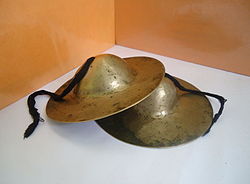Manjira
 |
The taal (Assamese: তাল; Odia: ଗିନି, Gini ), manjira (also spelled manjīrā or manjeera), jalra, khartàl or gini is a pair of clash cymbals, which make high-pitched percussion sounds. In its simplest form, it consists of a pair of small hand cymbals. The word taal comes from the Sanskrit word Tālà, literally means a clap. It is a part of Indian music and culture, used in various traditional customs e.g. Bihu music, Harinaam etc.
In Hindu religious contexts it is known as karatalas (Sanskrit: करताळं, IAST: Karatāḷaṁ), pronounced "karataala", (literally beat-tala maker-kara) , typically used to accompany devotional music such as bhajan and kirtan. They are commonly used by Hare Krishna devotees when performing harinam, but are ubiquitous to all Hindu devotional music.
The clash cymbal, taal is made of bell metals i.e. bronze, brass, copper, zinc etc. Each cymbal is connected with a cord which passes through hole in its center. The pitch of different types of taal vary according to their size, weight and the materials used. A player can also adjust the timbre by varying the point of contact while playing.
Manjiras are usually made of bronze, brass, copper, or zinc. The name manjira or khartal can also refer to a similar instrument made of a wooden frame with rows of cymbals inside.
There are many types of Taal, categorised by size, weight and appearance.
Manjiras are commonly played in folk and devotional music. They are played in various religious events and ceremonies in India and especially in bhajans. Manjiras are ancient musical instruments. Manjiras can be seen in many ancient temple pictures.
...
Wikipedia
